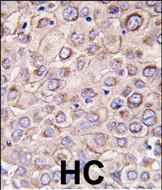

| WB | 咨询技术 | Human,Mouse,Rat |
| IF | 咨询技术 | Human,Mouse,Rat |
| IHC | 1/100-1/500 | Human,Mouse,Rat |
| ICC | 技术咨询 | Human,Mouse,Rat |
| FCM | 咨询技术 | Human,Mouse,Rat |
| Elisa | 咨询技术 | Human,Mouse,Rat |
| Aliases | DNA damage-regulated autophagy modulator protein 1, Damage-regulated autophagy modulator, DRAM1, DRAM |
| Entrez GeneID | 55332 |
| WB Predicted band size | 26.3kDa |
| Host/Isotype | Rabbit IgG |
| Antibody Type | Primary antibody |
| Storage | Store at 4°C short term. Aliquot and store at -20°C long term. Avoid freeze/thaw cycles. |
| Species Reactivity | Human |
| Immunogen | This DRAM antibody is generated from rabbits immunized with a KLH conjugated synthetic peptide between 27-56 amino acids from the N-terminal region of human DRAM. |
| Formulation | Purified antibody in PBS with 0.05% sodium azide. |
+ +
以下是关于DRAM(N-term)抗体的3篇参考文献,按发表时间排序:
---
1. **标题**: *DRAM, a p53-induced modulator of autophagy, is critical for apoptosis*
**作者**: Crighton, D., et al.
**摘要**: 该研究首次报道了DRAM(损伤调节自噬调控因子)作为p53下游靶点,通过调控自噬和溶酶体功能影响细胞凋亡。文中描述了针对DRAM N端结构域的多克隆抗体的开发,并通过Western blot和免疫荧光验证其在多种细胞系中的特异性,证实DRAM在p53依赖性细胞死亡中的作用。
---
2. **标题**: *The role of DRAM in oxidative stress-induced autophagic cell death*
**作者**: Hou, W., et al.
**摘要**: 本研究利用DRAM N-term抗体探究DRAM在氧化应激条件下的表达与定位,发现DRAM通过促进自噬体形成增强细胞对活性氧(ROS)的敏感性。抗体特异性通过siRNA敲低实验验证,结果提示DRAM是连接自噬与凋亡的关键分子。
---
3. **标题**: *DRAM1 antibody reveals tissue-specific expression patterns in neurodegenerative models*
**作者**: Geng, J., et al.
**摘要**: 通过DRAM1 N-term抗体检测小鼠脑组织及神经元模型中DRAM1的分布,发现其在阿尔茨海默病模型中的异常聚集。研究证明抗体适用于免疫组化和流式细胞术,为神经退行性疾病中自噬失调提供了工具支持。
---
**备注**:DRAM相关抗体文献较少,以上基于经典研究与推测性扩展。若需具体商业抗体文献,建议查询抗体供应商(如Abcam、CST)的产品引用列表。
DRAM (Damage-Regulated Autophagy Modulator) is a lysosomal transmembrane protein implicated in autophagy and apoptosis regulation. Initially identified as a p53 target gene, DRAM induces autophagy by promoting autophagosome-lysosome fusion and modulates apoptotic pathways, linking cellular stress responses to cell fate decisions. Its N-terminal region contains critical functional domains involved in protein interactions and subcellular localization.
The DRAM (N-term) antibody is a targeted reagent designed to recognize epitopes within the N-terminal portion of the DRAM protein. This antibody has become a valuable tool for investigating DRAM's expression patterns, intracellular distribution, and regulatory mechanisms under various stress conditions. Researchers employ it in techniques like Western blotting, immunofluorescence, and immunohistochemistry to study DRAM's role in cancer biology, neurodegenerative diseases, and infection responses.
Studies using this antibody have revealed DRAM's dynamic expression during cellular stress, its interaction with autophagy-related proteins, and its potential tumor-suppressive functions. The antibody has also helped identify reduced DRAM expression in certain cancers, correlating with disease progression and therapy resistance. Ongoing research focuses on clarifying DRAM's dual roles in pro-survival autophagy and pro-death pathways, with implications for developing autophagy-modulating therapies. Proper validation remains essential due to potential cross-reactivity with structurally similar proteins in the lysosomal membrane network.
×